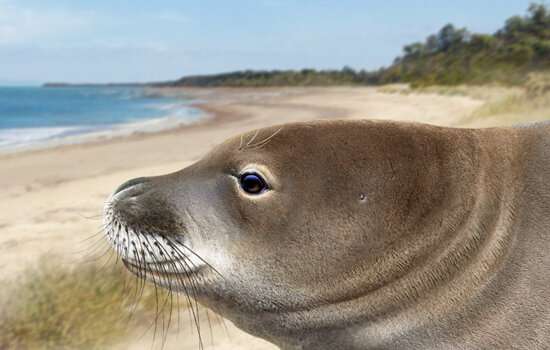World's most endangered seals were once widespread in Australia, scientists find

Fossil discoveries in Victoria now reveal that monk seals were widespread in Australasia in the past.
The finding is outlined in the publication "Early monk seals (Monachinae: Monachini) from the late Miocene–early Pliocene of Australia," published in the Journal of Systematic Palaeontology.
"Monk seals are one of the rarest and most endangered marine mammals alive today, but this wasn't always the case," according to lead study author Dr. James Rule, from the Monash University School of Biological Sciences.
"This paper reveals that the critically endangered monk seals once called Australia home approximately five million years ago (specifically in Victoria)," he said.
The discovery was made by revisiting two fossils from Melbourne Museums' collections, the identity of which had been a mystery for 40 years.
"When we analyzed them, they turned out to be the oldest evidence of monk seals," Dr. Rule said.
"These fossils (along with the extinct New Zealand species discovered last year) double the known diversity of the monk seals," he said.
According to Dr. Rule, monk seals became extinct in Australasia after 3 million years ago, and were restricted to the tropics and the Mediterranean after temperatures fell during the Ice Ages.
This left monk seals on the brink of extinction after overhunting by humans, with roughly 2000 individuals left.
The discovery of Eomonachus and the Australian monk seals led the researchers to re-investigate the origins of the group.
"Our research indicates that monk seals evolved in Australasia," Dr. Rule said.
"This is in contrast with every theory previously put forward by scientists."
Previous research has theorized this change in climate spurred the extinction of many ancient seals in the Southern Hemisphere. This would have included Eomonachus, as well as the Australian monk seals.
"This suggests the world's last two species of monk seal, vestiges of what was once likely a widespread group, are also at risk from climate change," Dr. Rule said.
If sea levels continue to rise, the beaches monk seals rely on for resting and breeding may disappear. Rising temperatures could also disrupt food webs, making it difficult for them to find food.
More information: James P. Rule et al, Early monk seals (Monachinae: Monachini) from the late Miocene–early Pliocene of Australia, Journal of Systematic Palaeontology (2021). DOI: 10.1080/14772019.2021.1920639
Journal information: Journal of Systematic Palaeontology
Provided by Monash University





















